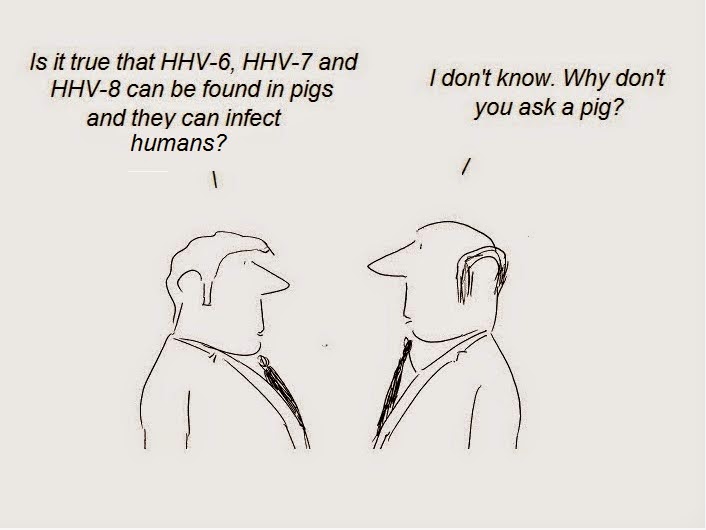Technology Could Help Detect Diseases in Commercial Swine Industry
http://www.labmanager.com/news/2015/05/technology-could-help-detect-diseases-in-commercial-swine-industry?fw1pk=2#.VVyevEab4gQ
Russian Scientist: ASF could become a human health risk
"The African swine fever (ASF) virus, may in the future become
dangerous for humans, according to the head of the Russian Epidemiology
Service, Chief State Sanitary Doctor Gennady Onishchenko, at the
press-conference in St. Petersburg. According to him almost all viruses
from time to time go through mutation processes which can give them some
additional functions."
http://www.pigprogress.net/Health-Diseases/Outbreaks/2013/7/ASF-could-become-a-human-health-risk-1308047W/
Background on African Swine Fever Virus as a human pathogen:
"African Swine fever is an endemic disease in sub-Saharan Africa and
many other parts of the developing world. It is caused by the African
Swine virus that primarily replicates in macrophages and monocytes
leading to the impairment of the structure and function of the immune
system of the infected organisms. Until now the African Swine epidemic
continues to spread despite all efforts to contain it. Thus, there is
an objective need for effective, safe and affordable preventive and
therapeutic approaches, in particular for effective vaccines, to
control and eventually eradicate this disease. Since the characteristic
feature of the African Swine virus is to impair the immune system and
to cause immune deficiencies in its hosts the development of vaccines
and other therapeutic approaches against the African Swine virus has
implications for other immune deficiencies or diseases. Several other
viruses are also known to cause immunodeficiency-like syndromes in
humans, including cytomegalovirus, Epstein Barr Virus
and others. Moreover, a series of cases of so-called "idiopathic"
immunodeficiencies have been documented that display
CD4+T-lymphocytopenia with opportunistic infections, but show no
evidence of HIV infection. Since antibodies for the African Swine virus
have been detected in humans, the possibility of human infection with
the African Swine virus exists and may thus far have escaped any systematic screening. Thus, any preventive and therapeutic approach to African Swine fever can have far-reaching implications to control immune deficiency conditions in humans."http://www.faqs.org/patents/app/20080207875
Detection of Novel Sequences Related to African Swine Fever Virus in Human Serum and Sewage.
Loh J, Zhao G, Presti RM, Holtz LR, Finkbeiner SR, Droit L, Villasana Z, Todd C, Pipas JM, Calgua B, Girones R, Wang D, Virgin HW.
Departments of Pathology & Immunology and Molecular Microbiology, Department of Medicine and Department of Pediatrics, Washington University School of Medicine, St. Louis, Missouri; Department of Biological Sciences, University of Pittsburgh, Pittsburgh, Pennsylvania; Department of Microbiology, Faculty of Biology, University of Barcelona, Barcelona, Spain.
"The family Asfarviridae contains only a single virus species, African swine fever virus (ASFV). ASFV is a viral agent with significant economic impact due to its devastating effects on populations of domesticated pigs during outbreaks, but has not been reported to infect humans. We report here the discovery of novel viral sequences in human serum and sewage which are clearly related to the Asfarvirus family, but highly divergent from ASFV. Detection of these sequences suggests that greater genetic diversity may exist among Asfarviruses than previously thought, and raises the possibility that human infection by Asfarviruses may occur."
http://www.ncbi.nlm.nih.gov/pubmed/19812170?dopt=AbstractDetection of Novel Sequences Related to African Swine Fever Virus in Human Serum and Sewage.
Loh J, Zhao G, Presti RM, Holtz LR, Finkbeiner SR, Droit L, Villasana Z, Todd C, Pipas JM, Calgua B, Girones R, Wang D, Virgin HW.
Departments of Pathology & Immunology and Molecular Microbiology, Department of Medicine and Department of Pediatrics, Washington University School of Medicine, St. Louis, Missouri; Department of Biological Sciences, University of Pittsburgh, Pittsburgh, Pennsylvania; Department of Microbiology, Faculty of Biology, University of Barcelona, Barcelona, Spain.
"The family Asfarviridae contains only a single virus species, African swine fever virus (ASFV). ASFV is a viral agent with significant economic impact due to its devastating effects on populations of domesticated pigs during outbreaks, but has not been reported to infect humans. We report here the discovery of novel viral sequences in human serum and sewage which are clearly related to the Asfarvirus family, but highly divergent from ASFV. Detection of these sequences suggests that greater genetic diversity may exist among Asfarviruses than previously thought, and raises the possibility that human infection by Asfarviruses may occur."
African Swine Fever Virus (Asfarviridae) sequences found in people with febrile illnesses
Abstract
Virus Identification in Unknown Tropical Febrile Illness Cases Using Deep Sequencing
Dengue virus is an emerging infectious agent that infects an estimated
50–100 million people annually worldwide, yet current diagnostic
practices cannot detect an etiologic pathogen in ∼40% of dengue-like
illnesses. Metagenomic approaches to pathogen detection, such as viral
microarrays and deep sequencing, are promising tools to address
emerging and non-diagnosable disease challenges. In this study, we
used the Virochip microarray and deep sequencing to characterize the
spectrum of viruses present in human sera from 123 Nicaraguan patients
presenting with dengue-like symptoms but testing negative for dengue
virus. We utilized a barcoding strategy to simultaneously deep
sequence multiple serum specimens, generating on average over 1
million reads per sample. We then implemented a stepwise bioinformatic
filtering pipeline to remove the majority of human and low-quality
sequences to improve the speed and accuracy of subsequent unbiased
database searches. By deep sequencing, we were able to detect virus
sequence in 37% (45/123) of previously negative cases. These included
13 cases with Human Herpesvirus 6 sequences. Other samples contained
sequences with similarity to sequences from viruses in the Herpesviridae, Flaviviridae, Circoviridae, Anelloviridae, Asfarviridae, and Parvoviridae
families. In some cases, the putative viral sequences were virtually
identical to known viruses, and in others they diverged, suggesting
that they may derive from novel viruses. These results demonstrate the
utility of unbiased metagenomic approaches in the detection of known
and divergent viruses in the study of tropical febrile illness.
Detection of African swine fever virus-like sequences in ponds in the Mississippi Delta through metagenomic sequencing
" . .. further study is needed to characterize their potential risks to both public health and agricultural development."http://link.springer.com/article/10.1007%2Fs11262-013-0878-2



















